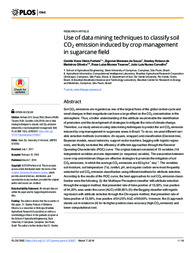Use of data mining techniques to classify soil CO2 emission induced by crop management in sugarcane field.
Use of data mining techniques to classify soil CO2 emission induced by crop management in sugarcane field.
Author(s): FARHATE, C. V. V.; SOUZA, Z. M. de; OLIVEIRA, S. R. de M.; TAVARES, R. L. M.; CARVALHO, J. L. N.
Summary: Soil CO2 emissions are regarded as one of the largest flows of the global carbon cycle and small changes in their magnitude can have a large effect on the CO2 concentration in the atmosphere. Thus, a better understanding of this attribute would enable the identification of promoters and the development of strategies to mitigate the risks of climate change. Therefore, our study aimed at using data mining techniques to predict the soil CO2 emission induced by crop management in sugarcane areas in Brazil. To do so, we used different variable selection methods (correlation, chi-square, wrapper) and classification (Decision tree, Bayesian models, neural networks, support vector machine, bagging with logistic regression), and finally we tested the efficiency of different approaches through the Receiver Operating Characteristic (ROC) curve. The original dataset consisted of 19 variables (18 independent variables and one dependent (or response) variable). The association between cover crop and minimum tillage are effective strategies to promote the mitigation of soil CO2 emissions, in which the average CO2 emissions are 63 kg ha-1 day-1. The variables soil moisture, soil temperature (Ts), rainfall, pH, and organic carbon were most frequently selected for soil CO2 emission classification using different methods for attribute selection. According to the results of the ROC curve, the best approaches for soil CO2 emission classification were the following: (I)-the Multilayer Perceptron classifier with attribute selection through the wrapper method, that presented rate of false positive of 13,50%, true positive of 94,20% area under the curve (AUC) of 89,90% (II)-the Bagging classifier with logistic regression with attribute selection through the Chi-square method, that presented rate of false positive of 13,50%, true positive of 94,20% AUC of 89,90%. However, the (I) approach stands out in relation to (II) for its higher positive class accuracy (high CO2 emission) and lower computational cost.
Publication year: 2018
Types of publication: Journal article
Observation
Some of Embrapa's publications are published as ePub files. To read them, use or download one of the following free software options to your computer or mobile device. Android: Google Play Books; IOS: iBooks; Windows and Linux: Calibre.
Access other publications
Access the Agricultural Research Database (BDPA) to consult Embrapa's full library collection and records.
Visit Embrapa Bookstore to purchase books and other publications sold by Embrapa.

